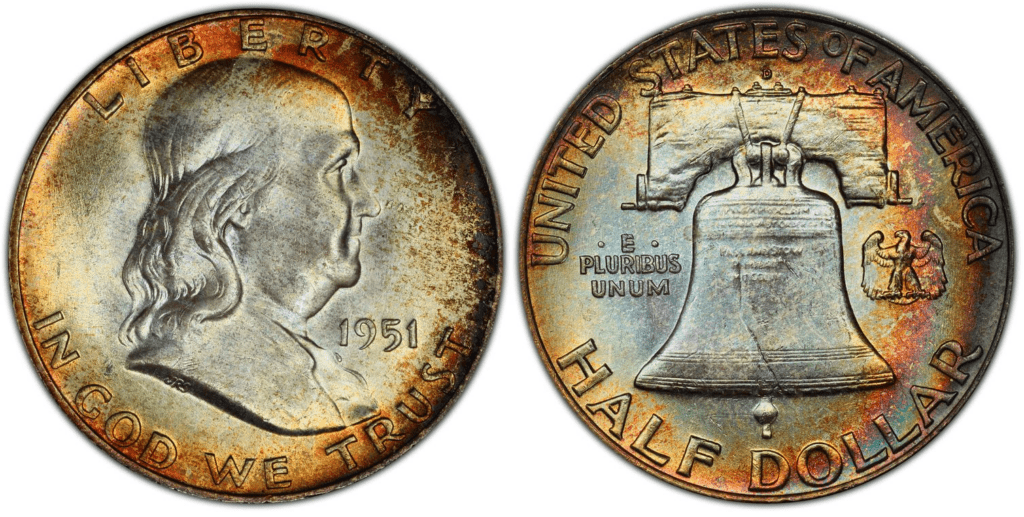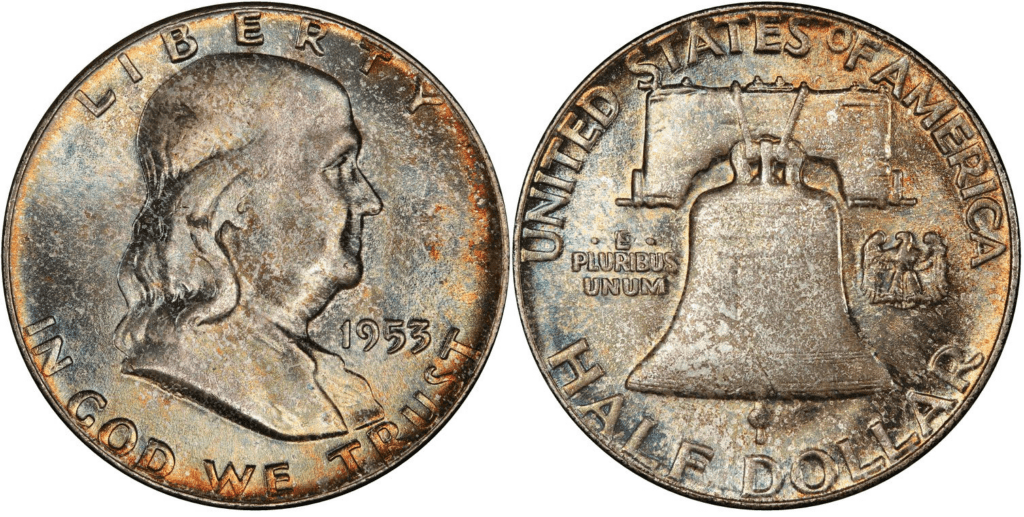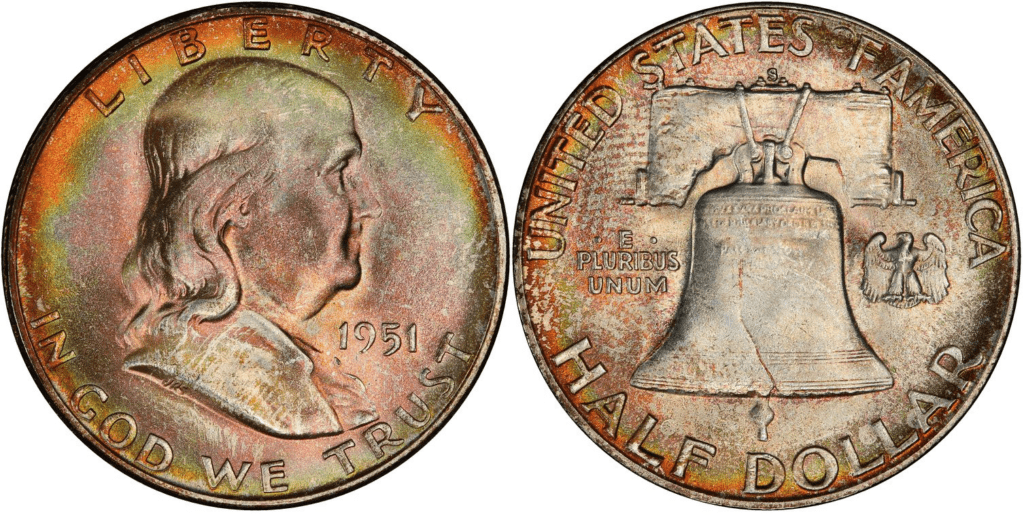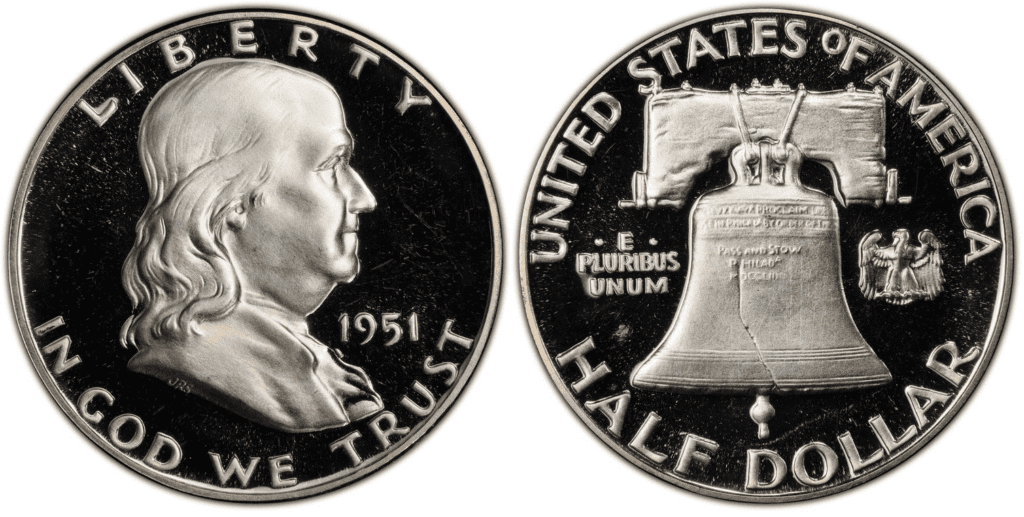What Is the 1951 Franklin Half Dollar Made Of?
The 1951 Franklin half-dollar is made of 90% silver and 10% copper. Specifically, it contains 0.36169 troy oz of silver. It weighs 12.50 grams, has a diameter of 30.61 mm, a thickness of 1.8 mm, a reeded edge, and a value of 50 cents.
The Franklin half-dollar was first issued in 1948 and was in production until 1963. With over half a century of production, we can see that the Franklin half a dollar is among the most widely recognized coins in the United States.
The Franklin half-dollar in 1951 has Benjamin Franklin’s image on the obverse. Franklin is a Founding Father, and adding him to the coin was a way to honor him. However, Franklin is a humble and practical person. Therefore, he might not like the idea of having him on a coin.
Nevertheless, Nellie Tayloe Ross, the Mint director who spearheaded the movement of having Franklin on a coin, explained that at that time, Franklin only knew of living royalties being added to the coin. So, he might have a different perspective if the main objective of adding a portrait on a coin is to honor a deceased founder of the republic.

When it comes to design, Franklin’s bust is on the obverse. Inscriptions include the following:
- LIBERTY
- IN GOD WE TRUST
- 1951
On the reverse, you’ll find the Liberty Bell with a small eagle on the right side. The eagle was just added since the law required all US silver coins to have an image of the eagle.
Inscriptions include the following:
- UNITED STATES OF AMERICA
- HALF DOLLAR
- E PLURIBUS UNUM
1948 marks the first year of the Franklin half-dollar. The half-dollar was the last coin that didn’t receive a design that included a portrait of a famous American. At that time, the public was supportive of having Franklin to the dime since he was credited to have said the old maxim, “A penny saved is twopence clear.”
However, Ross chose the half-dollar because it is bigger and would be perfect to showcase the newly designed portrait of Franklin. The choice of the Liberty Bell also complements Franklin since he and the bell are closely related to Philadelphia.
1951 Franklin Half Dollar Varieties
The 1951 Franklin fifty-cent coins were produced in at least four varieties, which include the 1951-D, 1951-P, 1951-S, and 1951 Proof. Apart from these varieties, some half-dollar coins were also made with minting errors.
Let’s take a look at the description of these varieties and coin errors below:
1951 D Franklin Half Dollar
Edge: Reeded
Mint Mark: D
Place of minting: Denver
Year of minting: 1951
Face Value: $0.50 (fifty cents)
Price: $3 to $35 (or more)
Quantity produced: 9,475,200
Designer: John R. Sinnock
Composition: 90% Silver, 10% Copper
Mass: 2.50 grams
Diameter: 30 mm
Thickness: 1.8 mm

They produced more than 9 million of the 1951 Franklin Half Dollar value coin at the Denver mint. The Denver Mint produces the best quality coins compared to other mint centers. 1951-D half-dollars can be sold for $3 to $35 or more.
1951 P Franklin Half Dollar
Edge: Reeded
Mint Mark: none
Place of minting: Philadelphia
Year of minting: 1951
Face Value: $0.50 (fifty cents)
Price: $0.50 to $28 (or more)
Quantity produced: 16,802,102
Designer: John R. Sinnock
Composition: 90% Silver, 10% Copper
Mass: 2.50 grams
Diameter: 30 mm
Thickness: 1.8 mm

The 1951-P Franklin Half Dollar is known for its highest mintage since World War II. With more than 16 million half-dollar coins, the 1951-P 50 cent was also the most abundant variety of that year.
Although the mintage figure was good news, the quality control was poor. The dies for 1951-P were used so much that they began to wear out in the middle of the production. As a result, 1951-P generally has poor coin results. The problem persisted until new master hubs were made in 1960.
Most 1951-P fifty cents today are in circulated condition. Coins with grades above MS63 are scarce. Even 1951-P half-dollars with FBL rating are scarcer.
The usual price of the 1951-P half dollars may range from $0.50 to $28.
1951 S Franklin Dollar
Edge: Reeded
Mint Mark: S
Place of minting: San Francisco
Year of minting: 1951
Face Value: $0.50 (fifty cents)
Price: $0.50 to $48 (or more)
Quantity produced: 13,696,000
Designer: John R. Sinnock
Composition: 90% Silver, 10% Copper
Mass: 2.50 grams
Diameter: 30 mm
Thickness: 1.8 mm

In 1951, the San Francisco Mint issued more than 13.69 million half-dollar coins. This is actually the highest mintage figure of half-dollar coins from San Francisco. The Mint only produced Franklin half-dollars in 1949 and from 1951 to 1954.
Today, the 1951-S half dollar is common up to MS63 grades. It becomes scarcer and scarcer, beginning with MS64. According to some estimates, there are less than 1,000 1951-S coins with a grade of MS66 FBL rating. Less than a dozen of 1951-S coins with MS67 FB rating.
The price may range from $0.50 to $48.
1951 P Franklin Half Dollar (Proof)
Edge: Reeded
Mint Mark:
Place of minting: Philadelphia
Year of minting: 1951
Face Value: $0.50 (fifty cents)
Price: $0.50 to $235 (or more)
Quantity produced: 57,500
Designer: John R. Sinnock
Composition: 90% Silver, 10% Copper
Mass: 2.50 grams
Diameter: 30 mm
Thickness: 1.8 mm

Except for 1950, the 1951 proof fifty-cent coin is the lowest mintage from 1948 to 1963. Because there are only a few 1951 proof sets, the demand is higher, causing its price to inflate. That’s why you can easily find 1951-proof half-dollar coins worth hundreds of dollars. The usual price may range from $0.50 to $235.
Look for PR67 1951-proof coins. They are considered to be scarce. It is possible that only less than 200 pieces exist today. Any coin with a grade of at least PR67 would surely be valuable.
1951 Franklin Half Dollar Errors
The 1951 series of Franklin half-dollar coins is not free of any errors. Because of worn-out dies, there are many coins with poor strike quality. The engraved materials aren’t too pronounced, and they look smudgy.
Another error for the 1951 Franklin half dollar is the clashed dies. A die clash happens when the obverse and reverse dies to strike each other because the planchet between them is missing. Once the planchet is placed again, the clashed dies would cause distorted images on the coin.
For the 1951 Franklin half-dollar, the clashed die error caused Franklin to have “rabbit fangs,” which earned the coin the nickname “Bugs Bunny” Franklin coins.
Aside from that, there’s also the RPM error or repunched mintmark. This happens when the mint die hits the planchet twice, causing a slight doubling appearance on the mintmark. This error is particularly noticeable in the S variety.
How Much Is 1951 Franklin Half Dollar Worth Today?
The face value of the 1951 Franklin coin is 50 cents. Since the coin is made of silver, the melt value is higher at $8.7422. Nevertheless, some 1951 Franklin half dollars have an astronomically higher value than their face value or melt value.
Take a look at this 1951 Franklin Half Dollar values chart to learn more:
| Coin | Condition | Grade | Mintage | Value |
| 1951 D Franklin half dollar | Circulated/mint | Not graded | 9,475,200 | $9.75 to $23 |
| 1951 D Franklin half dollar | Uncirculated/mint | MS-64 | 9,475,200 | $36 to $102 |
| 1951 D Franklin half dollar | Uncirculated/mint | MS-65 | 9,475,200 | $109 to $144 |
| 1951 D Franklin half dollar | Uncirculated/mint | MS-66 | 9,475,200 | $156 to 450 |
| 1951 D Franklin half dollar | Full Bell Line | MS-66 | 9,475,200 | $361 to 750 |
| 1951 P Franklin half dollar | Circulated/mint | Not graded | 16,802,102 | $9.75 to $12.25 |
| 1951 P Franklin half dollar | Uncirculated/mint | MS-65 | 16,802,102 | $30 to $212 |
| 1951 P Franklin half dollar | Uncirculated/mint | MS-66 | 16,802,102 | $144 to $288 |
| 1951 P Franklin half dollar | Uncirculated/mint | MS-67 | 16,802,102 | $780 to $1,610 |
| 1951 P Franklin half dollar | Full Bell Line | MS-67 | 16,802,102 | $4,560 to $26,400 |
| 1951 S Franklin half dollar | Circulated/proof | Not graded | 13,696,000 | $9.75 to $23
|
| 1951 S Franklin half dollar | Uncirculated/proof | MS-65 | 13,696,000 | $53 to $94 |
| 1951 S Franklin half dollar | Uncirculated/proof | MS-66 | 13,696,000 | $132 to $245 |
| 1951 S Franklin half dollar | Uncirculated/proof | MS-67 | 13,696,000 | $720 to $2,585 |
| 1951 S Franklin half dollar | Full Bell Line | MS-67 | 13,696,000 | $4,080 to $16,800 |
| 1951 P Franklin half dollar (Proof) | Uncirculated/proof | PR-66 | 57,500 | $504 to $675 |
| 1951 P Franklin half dollar (Proof) | Uncirculated/proof | PR-67 | 57,500 | $1,234 to $2,520 |
| 1951 P Franklin half dollar (Proof) | Uncirculated/proof | PR-68 | 57,500 | $4,080 to $12,000 |
| 1951 P Franklin half dollar (Proof) | Cameo | PR-68 | 57,500 | $13,800 to $21,600 |
| 1951 P Franklin half dollar (Proof) | Deep Cameo | PR-68 | 57,500 | $11,700 to $33,600 |
As you can see, the price of the 1951 half dollar is to the roof. Now, if you want to have more idea of how much the 1951 half dollar has been sold in the past, take a look at these auction records for each variety:
- $82,250 – 1951 50C, DCAM (Proof) coin with a grade of PR67+DC sold in 08-02-2017 by Heritage Auctions
- $30,550 – 1951-S 50C, FBL (Regular Strike) coin with a grade of MS67 sold in 04-24-2013 by Heritage Auctions
- $26,400 – 1951 50C, FBL (Regular Strike) coin with a grade of MS67FBL sold in 08-20-2019 by Stack’s Bowers
- $5,500 – 1951-D 50C, FBL (Regular Strike) coin with a grade of MS66 sold in 09-30-2013 by eBay
How Does The Grading System Work?
The Sheldon Scale is used by numismatists to provide a numerical value to coins. The Sheldon Scale goes from poor (P-1) to perfect mint state (P-1) (MS-70). Coins were originally evaluated using words to reflect their condition (Good, Fair, Excellent, Etc.). Unfortunately, coin collectors and dealers had different ideas about what each of these terms represent.
Professional numismatists joined together in the 1970s and established CoinGrading standards. These numismatists now assign grades at key places on the seventy-point scale, using the most regularly utilized numeric points in conjunction with the original adjective grade. The following are the most common coin grades:
-
-
- (P-1) Poor – Indistinguishable and probably damaged; if used, must have a date and mintmark; otherwise, rather battered.
- (FR-2) Fair – Nearly smooth, but without the damage that a coin graded Poor often possesses. The coin must have enough detail to be identified.
- (G-4) Fair – Inscriptions have merged into the rims in some areas, and important elements have been mostly erased.
- (VG-8) Very Good- A little weathered, but all of the primary design elements are visible, albeit faintly. There is little if any, central detail left.
- (F-12) Good – The item is very worn, yet the wear is even, and the overall design details stand out clearly. Rims are almost completely isolated from the field.
- (VF-20) Very Fine – Moderately weathered, with some finer features still visible. The motto or all letters of LIBERTY are readable. Both sides of the coin have entire rims that are separated from the field.
- (EF-40) Extremely Fine – Gently used; all gadgets are visible, and the most important ones are bold. The finer details are bold and clear, however, light wear may be seen.
- (AU-50) Uncirculated – Slight evidence of wear on the coin’s design’s high points; may have contact marks; eye appeal should be adequate.
- (AU-58) Uncirculated Choice – Slight traces of wear, no severe contact marks, almost full mint shine, and great eye appeal.
- (MS-60) Mint State Basal – Strictly uncirculated; no indication of wear on the coin’s highest points, but an unsightly coin with reduced luster, visible contact marks, hairlines, and other flaws.
- (MS-63) Mint State Acceptable – Uncirculated, but with contact scratches and nicks, little reduced shine, but otherwise appealing appearance. The strike is weak to average.
- (MS-65) Mint State Choice – Uncirculated with great mint shine, very little contact blemishes, and exceptional eye appeal. The strike is unusually severe.
- (MS-68) Mint State Premium Quality – Uncirculated with superb luster, no obvious contact marks to the naked eye, and exceptional eye appeal. The strike is quick and appealing.
- (MS-69) Almost Perfect Mint State – Uncirculated with perfect brilliance, a sharp and appealing strike, and extremely good eye appeal. A near-perfect coin with minor imperfections in the planchet, strike, and contact markings (seen only under 8x magnification).
- (MS-70) Mint State Perfect – Under 8x magnification, there are no tiny imperfections discernible; the strike is crisp, and the coin is perfectly centered on a beautiful planchet. Rarely seen on a coin, this coin is bright and whole, with original luster and exceptional eye appeal.
-
Where To Buy Or Sell 1951 Franklin Half Dollar?
The most common place to buy a 1951 Franklin half dollar would be on the Internet. You can create an account on Amazon, eBay, or Etsy. These websites allow you to both sell and buy coins.
There are websites as well that specialize in buying and selling coins. These websites include JM Bullion, USA Coin Book, and CoinTrackers.
Offline, you can go to coin shops, pawnshops, and antique stores. You can also contact professional grading service providers with a list of available coins.
FAQs
Where is the mint mark on a 1951 half dollar?
The mint mark on a 1951 half dollar is on the coin’s reverse side. Look for the mint mark on top of the Liberty Bell, under the letter “E” of the word “STATES.”
Is a 1951 half dollar real silver?
The 1951 half dollar is made of 90% real silver, and the rest is copper.
